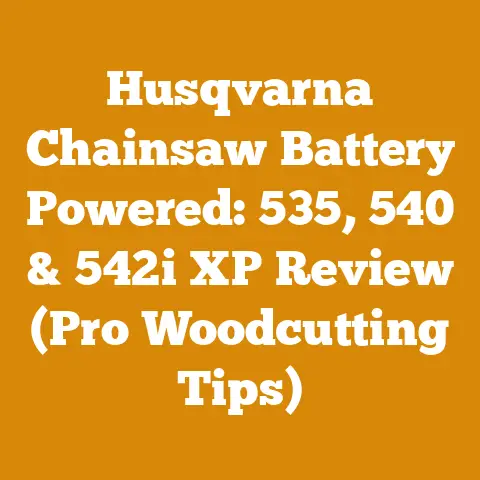6×6 vs 8×8 Posts for Pole Barns (7 Essential Wood Grain Tips)
Ever wondered if those extra two inches on an 8×8 post are really worth the money when building your pole barn?
It’s a question that’s crossed my mind more than once, especially when staring down a stack of lumber bills.
Over the years, I’ve learned that the answer isn’t always straightforward.
It depends on a whole host of factors, from the type of wood you’re using to the snow load in your area.
Today, I want to dive deep into the nitty-gritty of choosing between 6×6 and 8×8 posts for your pole barn, with a special focus on wood grain and how it impacts structural integrity.
We’ll cover everything from essential wood grain tips to load-bearing capacities and even some of the sneaky cost considerations that can make or break your project.
I’ll share some personal stories, data-backed insights, and practical tips that I’ve picked up over the years.
Let’s get started!
6×6 vs. 8×8 Posts for Pole Barns: 7 Essential Wood Grain Tips
Choosing the right posts for your pole barn is a critical decision.
It’s not just about the size; it’s about understanding the wood itself.
The wood grain, species, and treatment all play vital roles in the longevity and stability of your structure.
Understanding the Basics: Why Size Matters
Before we delve into wood grain, let’s establish why post size is so important.
Pole barns rely on posts to transfer the weight of the roof (including snow and wind loads) down to the ground.
The larger the post, the greater its load-bearing capacity.
1. Species Selection: Choosing the Right Wood
The type of wood you choose significantly impacts the strength and durability of your posts.
Here’s a breakdown of common options:
- Pressure-Treated Southern Yellow Pine (SYP): This is a popular choice due to its affordability and resistance to rot and insects.
It’s readily available in most regions.- Technical Detail: SYP typically has a specific gravity of around 0.55, indicating moderate density and strength.
- Douglas Fir: Known for its strength and straight grain, Douglas Fir is an excellent option for structural applications.
- Technical Detail: Douglas Fir has a specific gravity of around 0.48, slightly less dense than SYP, but its fiber strength is comparable.
- Western Red Cedar: Naturally resistant to decay, cedar is a good choice if you want to avoid chemical treatments.
However, it’s generally less strong than SYP or Douglas Fir.- Technical Detail: Western Red Cedar has a specific gravity of around 0.32, making it the least dense of the three.
Data Point: According to the USDA Forest Products Laboratory, the bending strength (MOR) of pressure-treated SYP is around 8,500 psi, while Douglas Fir is around 7,500 psi.
This means SYP can withstand slightly more bending force before breaking.
Key Consideration: Always opt for pressure-treated lumber for posts that will be in contact with the ground.
Look for lumber treated to UC4A standards for ground contact.
2. Wood Grain Orientation: The Key to Strength
The orientation of the wood grain is critical for load-bearing capacity.
Ideally, you want posts with vertical grain, also known as “quartersawn” or “rift sawn.”
- Vertical Grain: The grain runs vertically along the length of the post.
This orientation provides maximum strength and resistance to bending. - Flat Grain: The grain runs horizontally across the width of the post.
Flat-grain lumber is more prone to warping and splitting.
Visual Example: Imagine a stack of books.
If you place the books vertically, they can support a lot of weight.
If you lay them flat, they’ll buckle under pressure.
The same principle applies to wood grain.
Practical Tip: When selecting posts, look closely at the end grain.
The closer the growth rings are to being perpendicular to the face of the post, the stronger it will be.
3. Knot Placement: Avoiding Weak Points
Knots are a natural part of wood, but they can significantly weaken a post if they are large or poorly placed.
- Small, Tight Knots: These are generally acceptable and don’t significantly reduce strength.
- Large, Loose Knots: These can create weak points and should be avoided.
- Knots Near Edges: These are particularly problematic, as they can cause the wood to split under stress.
Rule of Thumb: As a general rule, I avoid posts with knots that are larger than one-third the width of the post.
Also, pay close attention to knots near edges or corners.
Case Study: I once inspected a pole barn that had collapsed during a windstorm.
The posts were 6×6 SYP, but several of them had large, loose knots near the base.
These knots had created points of failure, leading to the collapse.
4. Moisture Content: Ensuring Stability
The moisture content of your posts is crucial for long-term stability.
Wood shrinks and swells as it gains and loses moisture, which can lead to warping, cracking, and joint failure.
- Ideal Moisture Content: For structural applications, aim for a moisture content between 12% and 19%.
This is considered “air-dried” lumber. - Kiln-Dried Lumber: Kiln-dried lumber has been dried in a controlled environment to a lower moisture content (typically around 8%).
It’s more stable than air-dried lumber, but it’s also more expensive.
Technical Requirement: According to the American Wood Council, the allowable stress values for lumber are based on a moisture content of 19% or less.
If the moisture content is higher, you need to adjust the allowable stress values accordingly.
Practical Tip: Use a moisture meter to check the moisture content of your posts before installation.
Avoid using lumber that is visibly wet or has a moisture content above 20%.
5. Treatment Type and Penetration: Protecting Against Decay
Pressure treatment is essential for protecting posts that will be in contact with the ground.
The type of treatment and the depth of penetration are critical factors.
- CCA (Chromated Copper Arsenate): Once the industry standard, CCA is now restricted for most residential applications due to concerns about arsenic leaching.
- ACQ (Alkaline Copper Quaternary): A common alternative to CCA, ACQ is effective against rot and insects.
- CA (Copper Azole): Another popular option, CA is similar to ACQ but uses a different copper-based preservative.
Technical Specification: Look for lumber treated to UC4A standards for ground contact.
This means the preservative must penetrate deep into the wood to provide adequate protection.
Industry Standard: The American Wood Preservers Association (AWPA) sets standards for wood preservation.
Make sure your lumber meets these standards.
Personal Insight: I once used untreated lumber for a fence post, thinking it would be fine since it was above ground.
Within a few years, the post had rotted at the base and needed to be replaced.
Lesson learned: always use treated lumber for any application where the wood is exposed to moisture.
6. Load Calculations: Determining the Right Size
Choosing between 6×6 and 8×8 posts depends on the load-bearing requirements of your pole barn.
This involves calculating the roof load, snow load, wind load, and other factors.
- Roof Load: The weight of the roofing materials (e.g., metal, shingles)
- Snow Load: The weight of the snow that accumulates on the roof.
This varies depending on your geographic location. - Wind Load: The force exerted by the wind on the structure.
- Seismic Load: The force exerted by earthquakes (in earthquake-prone areas)
Technical Calculation:
- Determine the roof load: Multiply the weight of the roofing materials per square foot by the roof area.
- Determine the snow load: Consult local building codes for the snow load requirements in your area.
- Determine the wind load: Consult local building codes for the wind load requirements in your area.
- Calculate the total load: Add the roof load, snow load, and wind load.
- Determine the post spacing: Divide the total load by the number of posts to determine the load per post.
- Consult load tables: Use load tables provided by lumber suppliers or engineering resources to determine the required post size based on the load per post and the post height.
Example: Let’s say you’re building a 30×40 foot pole barn in an area with a snow load of 30 pounds per square foot.
The roof load is 5 pounds per square foot, and the wind load is 15 pounds per square foot.
- Roof Load: 30 ft x 40 ft x 5 lbs/sq ft = 6,000 lbs
- Snow Load: 30 ft x 40 ft x 30 lbs/sq ft = 36,000 lbs
- Wind Load: 30 ft x 40 ft x 15 lbs/sq ft = 18,000 lbs
- Total Load: 6,000 lbs + 36,000 lbs + 18,000 lbs = 60,000 lbs
If you’re using 10 posts, the load per post would be 6,000 lbs.
Consulting a load table, you might find that a 6×6 post is adequate for this load, but an 8×8 post would provide a greater margin of safety.
Key Consideration: Always consult with a qualified engineer or building inspector to ensure your pole barn meets local building codes and is structurally sound.
7. Cost Analysis: Balancing Strength and Budget
Finally, let’s talk about cost.
8×8 posts are more expensive than 6×6 posts, so it’s essential to weigh the cost against the benefits.
- Material Costs: 8×8 posts typically cost 50-100% more than 6×6 posts.
- Labor Costs: Larger posts may require more labor to install, especially if you’re doing it yourself.
- Long-Term Costs: Consider the long-term costs of maintenance and potential repairs.
Using larger, stronger posts can reduce the risk of structural failure and save you money in the long run.
Data Point: According to a recent survey of lumber prices, a 16-foot 6×6 pressure-treated post costs around $80, while a 16-foot 8×8 pressure-treated post costs around $150.
Sneaky Cost Consideration: Don’t forget to factor in the cost of fasteners and hardware.
Larger posts require larger, stronger fasteners, which can add to the overall cost.
Budget-Friendly Insight: Sometimes, you can save money by using 6×6 posts in areas with lighter loads and 8×8 posts in areas with heavier loads.
For example, you might use 8×8 posts for the main support columns and 6×6 posts for the side walls.
Additional Considerations for Pole Barn Posts
Beyond the essential wood grain tips, there are several other factors to consider when choosing posts for your pole barn.
Soil Conditions
The type of soil in your area can affect the stability of your pole barn.
Sandy soil, for example, provides less support than clay soil.
If you have poor soil conditions, you may need to use larger posts or reinforce the soil around the posts.
Technical Requirement: Conduct a soil test to determine the bearing capacity of your soil.
This will help you determine the appropriate post size and depth.
Post Embedment Depth
The depth to which you embed your posts is critical for stability.
The deeper the posts are embedded, the more resistant they will be to overturning.
Rule of Thumb: As a general rule, embed your posts at least 4 feet deep.
In areas with high winds or poor soil conditions, you may need to embed them even deeper.
Practical Tip: Use concrete to backfill around the posts.
This will provide additional support and prevent the posts from shifting.
Bracing and Framing
Proper bracing and framing are essential for distributing the load evenly across the posts.
Use diagonal braces to prevent racking and ensure that the posts are securely connected to the roof and walls.
Technical Detail: According to the International Building Code (IBC), diagonal braces should be installed at a 45-degree angle and should be securely fastened to the posts and beams.
Post Spacing
The spacing between your posts affects the load-bearing capacity of the structure.
The closer the posts are spaced, the less load each post has to carry.
Rule of Thumb: As a general rule, space your posts no more than 12 feet apart.
In areas with heavy snow loads, you may need to space them closer together.
Practical Tip: Use a post-hole digger or auger to dig the post holes.
This will make the job much easier and ensure that the holes are the correct size and depth.
Tools and Equipment
Installing pole barn posts requires a few essential tools and equipment.
- Post-Hole Digger or Auger: For digging the post holes.
- Level: For ensuring that the posts are plumb.
- Concrete Mixer: For mixing the concrete.
- Wheelbarrow: For transporting the concrete.
- Safety Glasses and Gloves: For protecting your eyes and hands.
Tool Calibration Standard: Ensure your level is properly calibrated before starting the project.
An inaccurate level can lead to structural problems.
Safety Precautions
Working with lumber and concrete can be dangerous. Take the following safety precautions:
- Wear safety glasses and gloves.
- Use caution when lifting heavy objects.
- Follow the manufacturer’s instructions for using power tools.
- Work in a well-ventilated area when mixing concrete.
- Be aware of overhead power lines.
Safety Code: Always follow OSHA (Occupational Safety and Health Administration) guidelines when working on construction projects.
Conclusion: Making the Right Choice
Choosing between 6×6 and 8×8 posts for your pole barn is a decision that requires careful consideration.
By understanding the essential wood grain tips, load-bearing requirements, and cost factors, you can make an informed choice that will ensure the safety and longevity of your structure.
Remember to consult with a qualified engineer or building inspector to ensure your pole barn meets local building codes and is structurally sound.
And don’t be afraid to ask questions and do your research.
Building a pole barn is a significant investment, and it’s worth taking the time to do it right.






